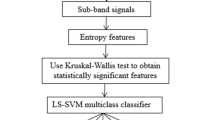Abstract
Many signal processing methods have been developed to detect gear system faults. However, signal noise greatly influences the monitoring process. In addition, useful fatigue information can be misinterpreted by other useless oscillation components in vibration signal and noise. These conditions lead to unclear results that hinder researchers from effectively detecting faults. To overcome this problem, this study first adopts wavelet theory to remove noise and then utilizes the empirical mode decomposition characteristics of the Hilbert-Huang transform to analyze useful Intrinsic mode functions (IMFs) on the basis of signal modulation and correlation theory. Sifted IMFs are then reconstructed as new signals called D-E signals. Finally, Hilbert energy spectrum and kurtosis value are used to complete fault diagnosis. This study compares the proposed method with the Discrete wavelet transform (DWT) method to verify the superiority of the proposed method. Experiment results from using different degrees of gear crack demonstrate that the proposed method is more sensitive in gear fault detection than the DWT method.
Similar content being viewed by others
References
Al-Arbi and Salem, Condition monitoring of gear system using vibration analysis, Ph.D. Thesis, University of Huddersfield (2012).
A. Belsak and J. Flasker, Wavelet analysis for gear crack identification, Engineering Failure Analysis, 16 (2009) 1983–1990.
I. Daubechies, The wavelet transform, Time-frequency localization and signal analysis, IEEE Trans. Inform. Theory, 36 (6) (1990) 961–1005.
C. Torrence and G. P. Compo, A practical guide to wavelet analysis, Bull. Amer. Meteor. Soc., 79 (1998) 61–78.
Z. K. Peng, P. W. Tse and F. L. Chu, A comparison study of improved Hilbert-Huang transform and wavelet transform: Application to fault diagnosis for rolling bearing, Mechanical Systems and Signal Processing, 19 (2005) 974–988.
Z. K. Peng, P. W. Tse and F. L. Chu, An improved Hilbert-Huang transform and its application in vibration signal analysis, Journal of Sound and Vibration, 286 (2005) 187–205.
N. E. Huang, Z. Shen, S. R. Long, M. C. Wu and H. H. Shih, The empirical mode decomposition and Hilbert spectrum for nonlinear and non-stationary time series analysis, Proceedings of the Royal Society of London A, 454 (1998) 903–995.
S. J. Loutridis, Damage detection in gear systems using empirical mode decomposition, Engineering Structures, 26 (2004) 1833–1841.
S. Sylvain, T. Paul and B. Andrew, Robust wavelet denoising, IEEE Transactions on Signal Processing, 49 (6) (2001) 1146–1152.
B. Mozaffari and M. A. Tinati, Blind source separation of speech sources in wavelet packet domains using Laplacian mixture model expectation maximization estimation in overcomplete cases, Journal of Statistical Mechanics: Theory and Experiment, P02004 (2007) 1–31.
D. L. Donoho and I. M. Johnstone, Ideal spatial adaptation by wavelet shrinkage, Biometrika, 81 (1994) 425–455.
D. L. Donoho, De-noising by soft-thresholding, IEEE Trans. Inform. Theory, 41 (1995) 613–627.
N. Tomohiko and K. Hirokazu, Fast signal reconstruction from magnitude spectrogram of continuous wavelet transform based on spectrogram consistency, Proc. of the 17th Int. Conference on Digital Audio Effects (DAFx-14) (2014) 1–5.
Ž. B. Jakovljević, Comparative analysis of Hilbert Huang and discrete wavelet transform in processing of signals obtained from the cutting process: An intermittent turning example, FME Trans., 41 (2013) 342–348.
Y. Guo, W. Yan and Z. Bao, Gear fault diagnosis of wind turbine based on discrete wavelet transform, Proceedings of the 8th World Congress on Intelligent Control and Automation (WCICA’10) (2010) 5804–5808.
N. E. Huang and Z. Wu, A review on Hilbert-Huang transform: Method and its application to geophysical studies, Review of Geophysics, 46 (2008) 1–23.
K. Shin and J. K. Hammond, Fundamental of signal processing for sound and vibration engineers, John Wiley & Sons, Ltd., England (2008) 131–134, 202–229.
P. Vecer, M. Kreidl and R. Smid, Condition indicators for gearbox condition monitoring systems, Acta Polytechnica, 45 (2005) 35–43.
T. Chai and R. P. Draxler, Root mean square error (RMSE) or mean absolute error (MAE)? -Arguments against avoiding RMSE in the literature, Geoscientific Model Development, 7 (2014) 1247–1250.
K. Wang, Phase information at tooth mesh frequency for gear crack diagnosis, Proceedings of the 2nd IEEE Conference on Industrial Electronics and Applications (ICIEA 2007), Harbin, China (23–25) (2007) 2712–2717.
Author information
Authors and Affiliations
Corresponding author
Additional information
Recommended by Associate Editor Cheolung Cheong
Shuai Jin is a graduate student in the Department of Mechanical Engineering at Inha University. He studied signal processing and health monitoring.
Sang-Kwon Lee was born in Pusan, Korea, in 1959. He acquired his bachelor’s degree in mechanical engineering from Pusan National University, Pusan, Korea. He received his Ph.D. degree in signal processing from the Institute of Sound and Vibration Research of Southampton University in the UK in 1998. He has accumulated 11 years of experience in automotive noise control by working with Hyundai Motor Co. and Renault-Samsung Motor Company in Korea. He moved to Inha University, Inchon, Korea in 1999. He has continued his sound and vibration research in the Department of Mechanical Engineering at Inha University.
Rights and permissions
About this article
Cite this article
Jin, S., Kim, JS. & Lee, SK. Sensitive method for detecting tooth faults in gearboxes based on wavelet denoising and empirical mode decomposition. J Mech Sci Technol 29, 3165–3173 (2015). https://doi.org/10.1007/s12206-015-0715-8
Received:
Revised:
Accepted:
Published:
Issue Date:
DOI: https://doi.org/10.1007/s12206-015-0715-8




